
Formal Matters: Reading the Materials of English Renaissance Literature
(Hardback)
Publishing Details
Formal Matters: Reading the Materials of English Renaissance Literature
By (Author) Allison Deutermann
Edited by Andras Kisery
Manchester University Press
Manchester University Press
2nd December 2013
United Kingdom
Classifications
Physical Properties
Hardback
272
Width 156mm, Height 234mm
Description
How do the formal properties of early modern texts, together with the materials that envelop and shape them, relate to the cultural, political, and social world of their production Formal matters: Reading the materials of English Renaissance literature answers this question by linking formalist analysis with the insights of book history. It thus represents the new English Renaissance literary historiography tying literary composition to the materials and material practices of writing. The book combines studies of familiar and lesser known texts, from the poems and plays of Shakespeare to jests and printed commonplace books. Its ten studies make important, original contributions to research on the genres of early modern literature, focusing on the involvement of literary forms in the scribal and print cultures of compilation, continuation, translation, and correspondence, as well as in matters of political republicanism and popular piety, among others. Taken together, the collection's essays exemplify how an attention to form and matter can historicise writing without abandoning a literary focus. -- .
Reviews
Above all what emerges from this fascinating collection of essays is the importance of material approaches to literary and nonliterary texts in dialogue with other modes of reading. As such, meaning is collaborative, constructed by diverse agents, including but not limited to authors, compilers, scribes, printers, stationers, and readers, and generated by physical and visual as well as textual forms such as script, typeface, page layout, paper, and size in other words, all the various material extratextual features that communicated significant meaning to early modern writers and readers.
James Daybell, University of Plymouth, Renaissance Quarterly 69.4 (Winter 2016)
Author Bio
Allison K. Deutermann is Assistant Professor of English at Baruch College, City University of New York
Andrs Kisry is Assistant Professor of English at The City College of New York, City University of New York
